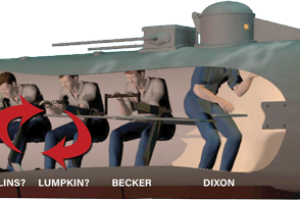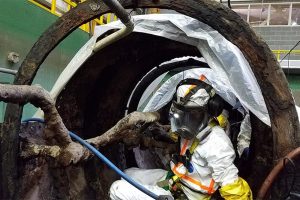For more information contact: For Immediate Release:
Kellen Correia at 843.743.4865, x.32 June 13th, 2011
Hidden Side of the Hunley Soon Revealed
Submarine to be Raised and Rotated over the Next Two Weeks
CHARLESTON, SC – The H. L. Hunley submarine has rested on her side at a 45-degree angle in exactly the same position she was found on the ocean floor after being lost at sea for well over a century. Today, the Hunley Project announced they plan to shift the vessel’s historic position this month, which will give the world an opportunity to see a portion of the submarine that has been hidden for generations. Archaeologists are eager for the opportunity to study this new area, which may hold clues as to why the Hunley was lost.
Since August 8th, 2000, the Hunley has remained cradled in the sling system that lifted her from the ocean. The slings have completely masked an entire part of the submarine. When the rotation project is completed, the submarine’s right side will be revealed for the first time since 1864. The overhead truss currently holding the submarine will also be removed, giving visitors a much better view of the Hunley during weekend public tours.
Rotating the estimated 10-ton, 40-foot Hunley will be a major engineering feat, particularly considering the overall fragility of this 19th century artifact. First, the Hunley must again be raised, but this time by only a few feet. It will be suspended in mid-air until support lifts are placed beneath the structure that holds it. The raising will take place this Wednesday, June 15th and will kick-off the rotation project, which is anticipated to last approximately ten days.
Mike Drews, Director of Clemson University’s Warren Lasch Conservation Center, said the safety of the submarine during this delicate procedure has been their top priority. “Conducting a major move like this can be nerve-racking because the Hunley is an irreplaceable and important part of our nation’s history. To ensure the submarine’s safety during the rotation, we have conducted a detailed and rigorous testing process. We’ve been very pleased with the results and feel confident in the plan we have in place.”
The rotation of the Hunley will usher in the final phases of the project. Once the submarine is upright, the concretion—a layer of shell, sediment, and rust—covering the Hunley will be removed, exposing the actual surface of the submarine. From there, scientists will be able to begin a comprehensive conservation treatment designed to ensure the Hunley survives for the benefit of future generations.
The Hunley Project
On the evening of February 17, 1864, the H. L. Hunley became the world’s first successful combat submarine by sinking the USS Housatonic. After signaling to shore that the mission had been accomplished, the submarine and her crew of eight mysteriously vanished. Lost at sea for over a century, the Hunley was located in 1995 by Clive Cussler’s National Underwater and Marine Agency (NUMA). The innovative hand-cranked vessel was raised in 2000 and delivered to the Warren Lasch Conservation Center, where an international team of scientists are at work to conserve the submarine for future generations and piece together clues to solve the mystery of her disappearance. The Hunley Project is conducted through a partnership with the Clemson University Restoration Institute, South Carolina Hunley Commission, Naval Historical Center, and Friends of the Hunley.



